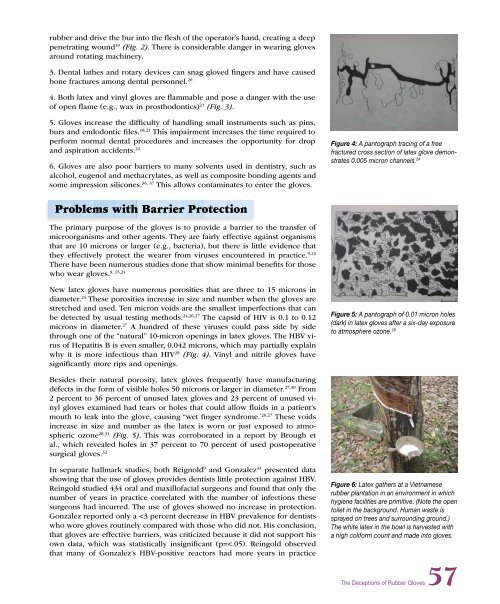PDF Version - Glidewell Dental Labs
PDF Version - Glidewell Dental Labs
PDF Version - Glidewell Dental Labs
You also want an ePaper? Increase the reach of your titles
YUMPU automatically turns print PDFs into web optimized ePapers that Google loves.
ubber and drive the bur into the flesh of the operator’s hand, creating a deep<br />
penetrating wound 19 (Fig. 2). There is considerable danger in wearing gloves<br />
around rotating machinery.<br />
3. <strong>Dental</strong> lathes and rotary devices can snag gloved fingers and have caused<br />
bone fractures among dental personnel. 20<br />
4. Both latex and vinyl gloves are flammable and pose a danger with the use<br />
of open flame (e.g., wax in prosthodontics) 21 (Fig. 3).<br />
5. Gloves increase the difficulty of handling small instruments such as pins,<br />
burs and endodontic files. 18,21 This impairment increases the time required to<br />
perform normal dental procedures and increases the opportunity for drop<br />
and aspiration accidents. 22<br />
6. Gloves are also poor barriers to many solvents used in dentistry, such as<br />
alcohol, eugenol and methacrylates, as well as composite bonding agents and<br />
some impression silicones. 36, 37 This allows contaminates to enter the gloves.<br />
Figure 4: A pantograph tracing of a free<br />
fractured cross section of latex glove demonstrates<br />
0.005 micron channels. 24<br />
Problems with Barrier Protection<br />
The primary purpose of the gloves is to provide a barrier to the transfer of<br />
microorganisms and other agents. They are fairly effective against organisms<br />
that are 10 microns or larger (e.g., bacteria), but there is little evidence that<br />
they effectively protect the wearer from viruses encountered in practice. 9,23<br />
There have been numerous studies done that show minimal benefits for those<br />
9, 15,24<br />
who wear gloves.<br />
New latex gloves have numerous porosities that are three to 15 microns in<br />
diameter. 24 These porosities increase in size and number when the gloves are<br />
stretched and used. Ten micron voids are the smallest imperfections that can<br />
be detected by usual testing methods. 24,26,27 The capsid of HIV is 0.1 to 0.12<br />
microns in diameter. 27 A hundred of these viruses could pass side by side<br />
through one of the “natural” 10-micron openings in latex gloves. The HBV virus<br />
of Hepatitis B is even smaller, 0.042 microns, which may partially explain<br />
why it is more infectious than HIV 29 (Fig. 4). Vinyl and nitrile gloves have<br />
significantly more rips and openings.<br />
Figure 5: A pantograph of 0.01 micron holes<br />
(dark) in latex gloves after a six-day exposure<br />
to atmosphere ozone. 28<br />
Besides their natural porosity, latex gloves frequently have manufacturing<br />
defects in the form of visible holes 50 microns or larger in diameter. 27,30 From<br />
2 percent to 36 percent of unused latex gloves and 23 percent of unused vinyl<br />
gloves examined had tears or holes that could allow fluids in a patient’s<br />
mouth to leak into the glove, causing “wet finger syndrome. ”26,27 These voids<br />
increase in size and number as the latex is worn or just exposed to atmospheric<br />
ozone 28,31 (Fig. 5). This was corroborated in a report by Brough et<br />
al., which revealed holes in 37 percent to 70 percent of used postoperative<br />
surgical gloves. 32<br />
In separate hallmark studies, both Reignold 9 and Gonzalez 33 presented data<br />
showing that the use of gloves provides dentists little protection against HBV.<br />
Reingold studied 434 oral and maxillofacial surgeons and found that only the<br />
number of years in practice correlated with the number of infections these<br />
surgeons had incurred. The use of gloves showed no increase in protection.<br />
Gonzalez reported only a

















